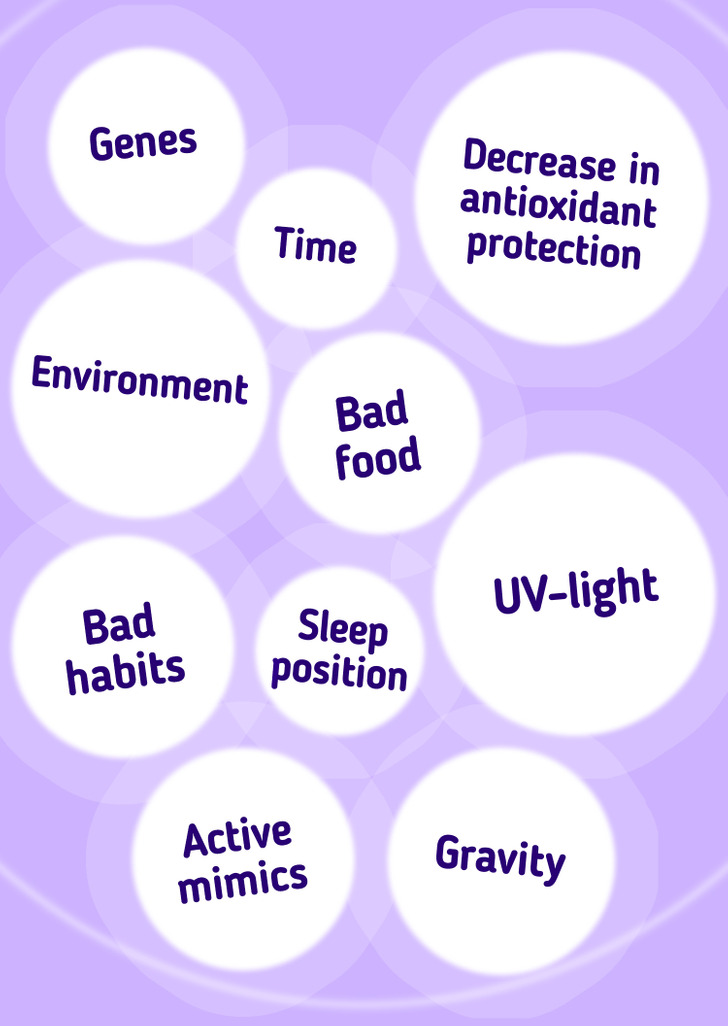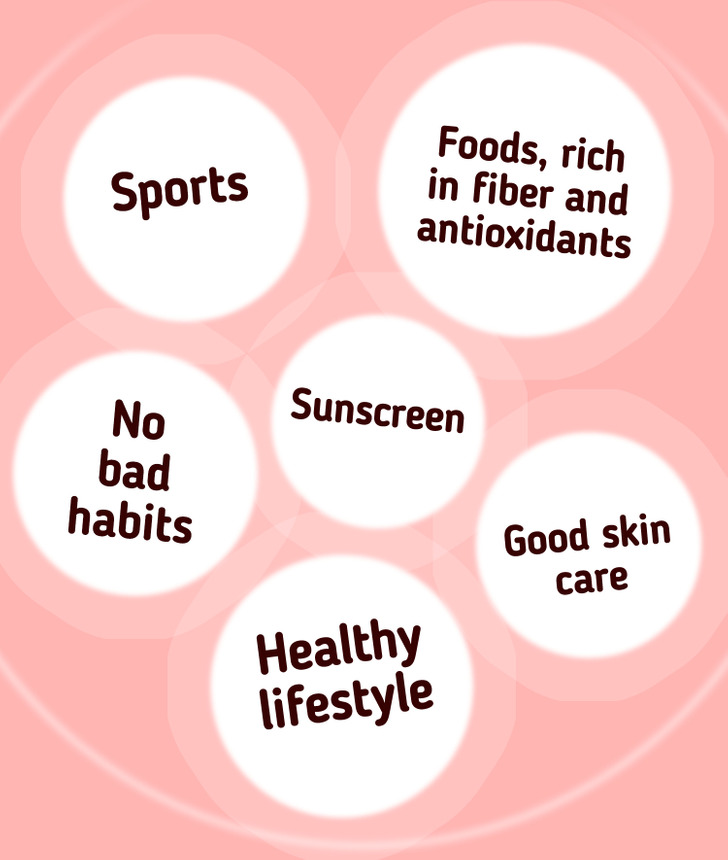How and Why Skin Gets Old
5-Minute Crafts is going to tell you why skin ages and what processes happen in it.
Structure and functions
Skin consists of 3 layers with muscles, bones, and internal organs under them.
- Epidermis is the 1st outer layer, which is a barrier from the infections of the environment. It regulates the amount of water that leaves the body. It’s as thick as a sheet of paper and it gives the skin its color.
- Dermis is the middle layer containing hair follicles, sweat glands, sebaceous glands (oil glands), apocrine glands, lymphatic vessels, nerves, and blood vessels. It’s made from collagen, elastic fibers, and matrix. It makes the skin strong and elastic.
- Hypodermis is the lowermost layer with the biggest blood vessels and nerves. It’s also where the fat is stored. It protects us from damage, acting as a shock absorber. The thickness of this layer varies around the entire body. For example, it’s thicker on the waist, thinner on the forehead and almost absent on the eyelids.
The skin has a few important functions:
- storing lipids and water
- synthesizing vitamin D
- thermoregulation
- sense of touch (vibration, temperature and so on)
Causes of aging

Aging is a complicated process leading to a change in the structure and function of the skin accompanied by such things as a decline in regeneration, impaired epidermal barrier function, decrease in infection resistance, loss of elasticity, and others.
With age, the connective tissue in the layers of the skin loses elasticity and strength which leads to wrinkles. The cell renewal slows down, so the skin becomes dry, thin, and saggy.
There are 2 types of skin aging: intrinsic and extrinsic.
Intrinsic (chronological) aging
Intrinsic (chronological) aging is an inevitable genetic process. It happens over time and as a result of the action of reactive oxygen species and ions forming during cell metabolism. With age, the amount of these chemicals increases but the antioxidant protection (that usually neutralizes them) decreases.
The beginning of chronological aging is determined genetically, so it’s individual for each person. On average, it starts after the age of 25 but it might not appear for decades.
The indicators of intrinsic aging:
- loss of underlying fat
- skin becoming thin
- loss of elasticity
- exaggerated expression lines
- skin becoming saggy
During chronological aging all 3 layers of the skin undergo certain changes:
- Epidermis loses nerve endings and it leads to a loss of sensitivity and slower reaction to irritations. Its contact with the dermis decreases, resulting in a reduced exchange of nutrients and metabolites between the two layers. The cell turnover decreases to 50% and the stratum corneum is not replaced quickly.
- Dermis loses 1% of collagen every year. There, just like in epidermis, the nerve endings disappear. The level of histamine decreases, the synthesis of collagen disrupts, and the ferments destroying collagen increase their numbers. The number of blood vessels decreases, so the skin becomes pale and the body temperature decreases.
- Hypodermis loses the underlying fat, so the thermal regulation becomes problematic. The underlying fat spreads around the body in a different way and its amount increases near the belly, hips, in the nasolabial folds, and submandibular regions.
Extrinsic aging
This is the result of different factors of the environment, such as dirty air, bad habits, or bad diet. Photoaging is also part of this process — it’s the result of exposure to UV-light. The other reasons are gravity, facial expressions, and position during sleep.
The signs of extrinsic aging are:
- pigment spots on the skin
- dischromia
- wrinkles
- saggy skin
This is how UV-light influences the epidermis:
- Causes irreparable damage to cellular DNA
- Reactive oxygen species are produced and just 30 minutes of UV-light exposure increases the level of ROS by 100%.
- The proteins making up the extracellular matrix and collagen are destroyed, so the structural integrity of the dermis is no longer there.
- The synthesis of collagen is disrupted, so there’s a deficiency of that in the skin.
- Pigmentation of the upper layer of the skin.
Prevention of skin aging

Even though aging is a natural and inevitable process, not everyone agrees to accept the way it influences the body. There are some things that scientists can help us with — they develop the methods that slow down aging.
But there are some other things we can do ourselves. According to scientists, the effect of age-related factors can be minimized with:
- regular weight-bearing exercises
- balanced diet, including fruit, vegetables, and other foods rich in antioxidants and fiber
- absence of bad habits
- sunscreen
- good skin care
- healthy lifestyle